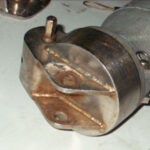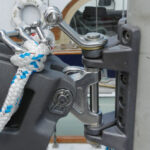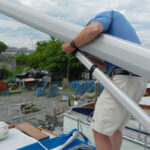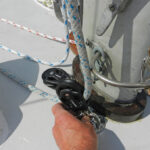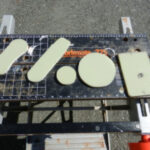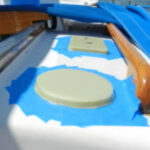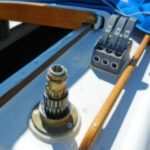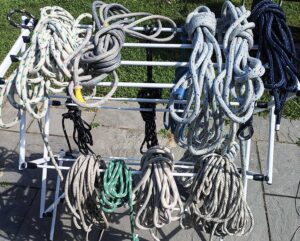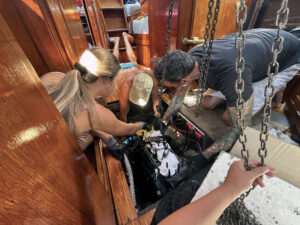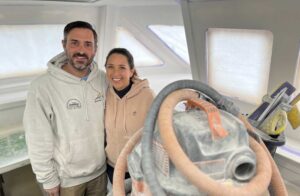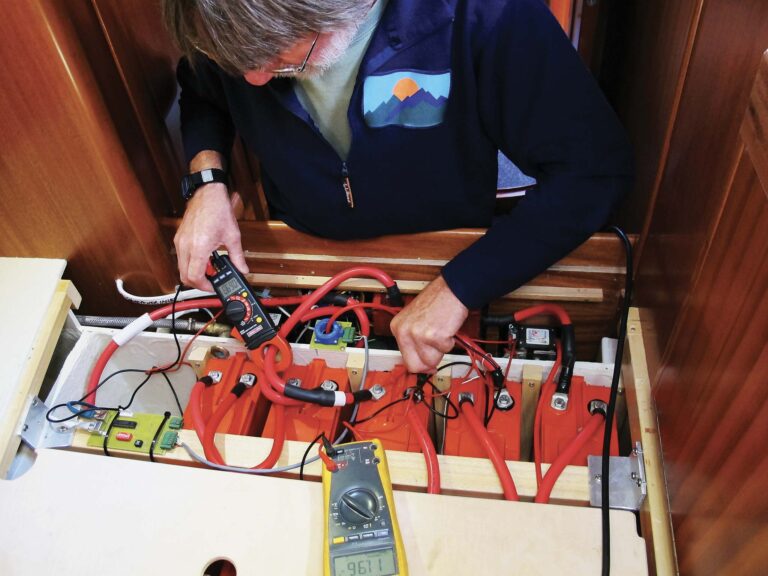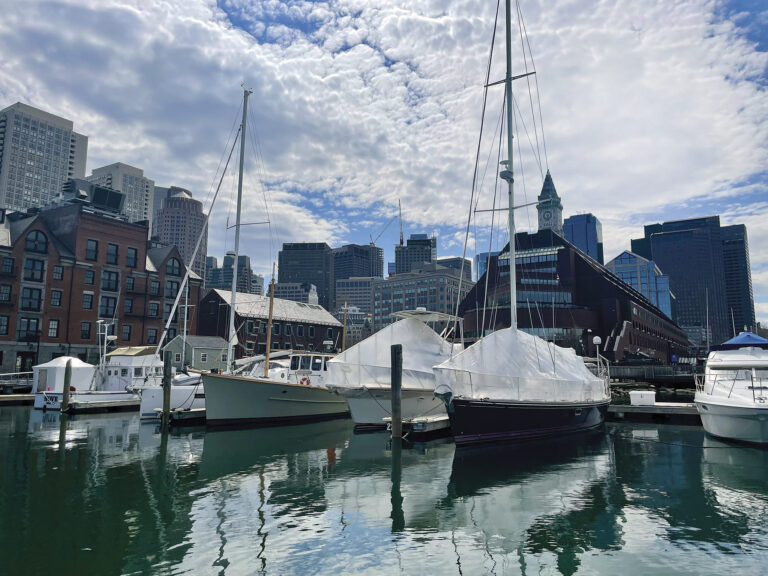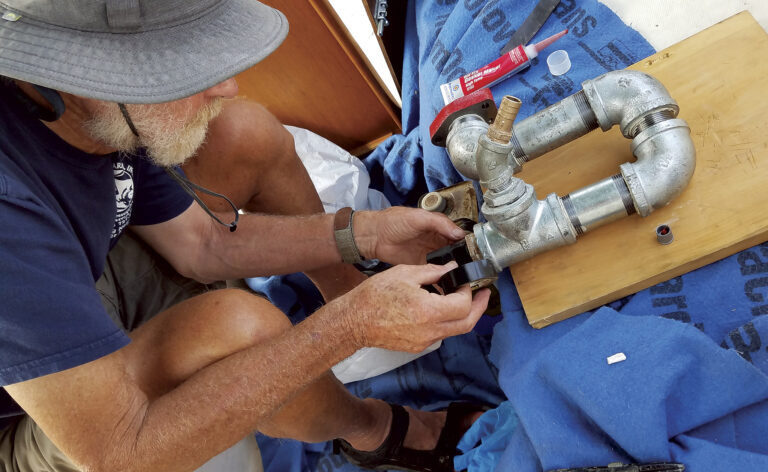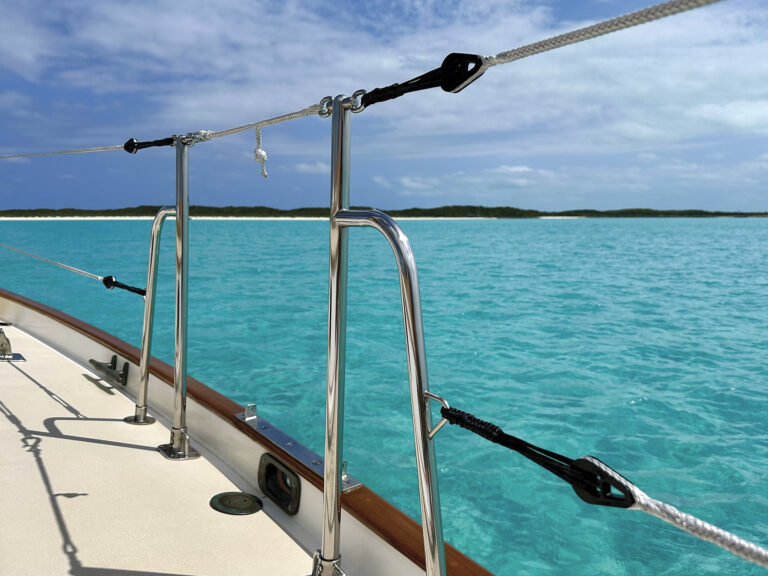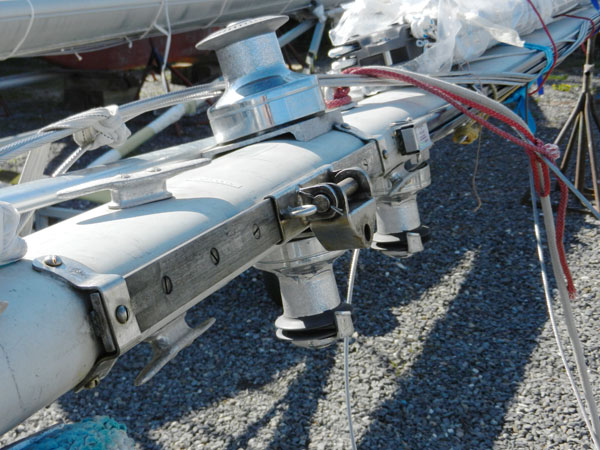
After purchasing new sails last year and installing a Tides Marine mainsail track, we decided it was time to upgrade the 45-year-old roller-reefing boom on our Allied Seabreeze 35 project boat Keewaydin. The old boom was in working order (for the most part), but I was suspicious of its effect on new sails and had cobbled together a makeshift slab-reefing system. It made me feel better about reefing, but required us to set the sails as we began the day, and then live with them until we were finished sailing—not the best way to enjoy the erratic Maine breeze.
To bring our sail-handling up to date, we elected to install a Seldén single-line reefing boom complete with a Rodkicker rigid vang. After measuring and ordering the boom, Scott Alexander from Seldén suggested we maximize the efficiency of the system by moving the mast-mounted halyard winch aft to the cabinhouse and set up a bank of turning blocks and clutches to handle the main halyard and the reefing lines.
Seldén’s single-line reefing boom uses a system of internal track-mounted slides to even the tension on the tack and clew as you pull in the reefing line. The boom comes with up to three reef lines pre-led, so setting up the system, once the boom is installed, is very easy.
It did take a bit of muscle and grease to remove the old hardware from the mast, but after a couple of attempts (with the help of liberal amounts of PB-Blaster, an impact screwdriver, and some requisite boatyard cursing) we finally got it off. The first step in mounting the new boom was to position the new gooseneck bracket so that the boom would be properly placed for luff hoist, boom height and alignments. Seldén makes a range of brackets to fit almost any mast section, and our mast, being 45 years old, required the company’s universal brackets for the boom and vang. After riveting both to the mast in our pre-measured spots, we filled the holes from the old hardware with rivets to seal the mast section.
Next, as we waited for the boatyard to step the mast, we put some preliminary pencil marks on the cabinhouse for siting the various pieces of line-handling hardware. Once the mast was in the boat, we set the boom and vang into their brackets. After that we held the boom in place with the old topping lift while we moved the vang around under the boom, looking for a position that allowed for the desired headroom in the cockpit and proper compression of the vang when in use and at rest.
With all set in place, we marked the boom for the pre-set vang fasteners, drilled the holes, and tightened them down. The boom comes with a set of sliding padeyes on its underside, which makes installing things like vangs and outhauls pretty straightforward. More hardware can easily be added if, for example, you want fairleads for lazy jacks (something I will do next season).
Next, it was time to position and mount the winch and hardware. First, we temporarily fixed the hardware in place with some tape and fed a small line through the Seldén blocks and Lewmar clutch bank to check the leads. Before marking the cabinhouse with pencil for each piece, we also double-checked the positions to give the best possible lead for the lines while avoiding any potential chafe. Unfortunately, the existing dodger on Keewaydin does not allow for very efficient use of the winch. But we’ll live with it for now and put it on the “for next year” list. What else is new in the world of upgrading old sailboats.
For some insight into how best to mount the new hardware, I consulted Joe Parker of Gougeon, who also owns an Allied Seabreeze. His solution was to epoxy-mount plates of 3/8in G-10 fiberglass to the cabintop, drill holes for the fasteners and then “pot” the fasteners with epoxy. This would create a 1/2in thickness of epoxy-reinforced fiberglass under the hardware. Gougeon suggests that a working load for such a mounting gives a 1/4in fastener a 1000lb pull out strength per inch of length in a direct tensile load, obviously somewhat dependent on the quality of the substrate. Because each mounting had at least 4 large fasteners, I thought strengths were adequate for the boat. This also meant I wouldn’t have to mar the headliner with any backing plates or bolts.
After receiving my G-10 from McMaster Carr, I first traced around the hardware pieces to create a pattern and then immediately discovered that cutting G-10 is not for the faint of heart. So I took my materials to our local fiberglass shop and had them cut out the pieces on their heavy-duty band saw. A bit of sanding and the plates were ready to mount.
One more dry fit of all the different parts, and I laid out my tools: West System Six-10 tubes, a caulking gun, gloves, a filleting tool for finishing off the edges and adding additional strength to the bond, and tape to hold things in place while the epoxy set.
After laying tape around the margins of each mounting area, I coated the back of each plate and its mounting area, and then pressed each into place. Using the filleting tool, I laid on some additional Six-10 to create a (sort of) smooth fillet around each piece. Clearly, I could use some practice doing this, but it would suffice! After removing the perimeter tape, I taped over the plates to hold them in place until things set up and we could return the next day to complete the job.
Parker recommended that I drill fastener holes roughly 25 percent larger than the diameter of the fasteners I would be using. Before making any holes, I also carefully sized the length of these fasteners so they would penetrate the plate and fiberglass cabin top but not the headliner. When I started drilling I could feel the drill bit go through the first two layers and then hit air, an indication that I had reached the proper depth. I then cleaned out the holes, dry fit the fasteners, pulled them out again, pumped in the Six-10 and put the fasteners back in again. After that, I cleaned up the excess epoxy and let things set.
Parker had said that a good pot of epoxy would create a sort of nut for the fastener between the cabintop and the headliner, adding additional strength to the mounting. I don’t anticipate needing to remove the hardware, so I did not use any kind of release agent on the fasteners. If it ever becomes necessary to remove them, Parker said he recommends using PAM Cooking Spray as it provides a very thin film and is cheap.
As we were slow in getting projects started this year and the Maine weather was too nice to complete all the needed sanding and painting of the mounting plates, it was time to go sailing…I’ll get to prettying up next year!
Once the main was bent on, the reef lines were attached to their respective tack positions on the sail using the provided shackles. The clew ends of the reef lines were wrapped once around the boom and secured to themselves with a bowline, one reef line on each side. They naturally adjust to the most advantageous position on the boom and are tensioned perfectly vertically when the reef line is pulled.
To reef the mainsail, I now simply ease the halyard to a pre-marked position from inside the cockpit, secure it in the clutch and then bring in the reefing line, using the winch for the final tensioning. It is a remarkably simple setup and very easy to operate. The sail is perfectly shaped and flattened to take on the higher wind speeds. The vang also helps with sail shape and, of course, takes the place of the topping-lift I used previously.
The Seabreeze is a tender boat with a big main, and any breeze above 15-18 knots really calls for a reef. Because Casco Bay, where we sail, has a pretty reliable afternoon sea breeze, we commonly sail home with a reef in. I must say being able to reef from the cockpit with one line has immeasurably improved our sailing and safety. Next on the sail-handling upgrade list is a traveler system.
Andy Howe is a regional sales representative for SAIL. He cruises Keewaydin out of Portland, Maine, with his wife Gay and their two dogs.

